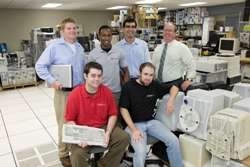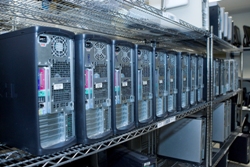Giving new life to old computers
| Paper, plastic, glass. Each has its place when the time comes to recycle. But what about a computer? What about thousands of computers each year? That was the dilemma facing Temple University’s Computer Services in 2003 when many computers were being dumped in the trash to avoid removal charges from the facilities department. With about 14,000 computers in operation at any given time, this was not only wasteful but also harmful to the environment, said Tim O’Rourke, Chief Information Officer and vice president of computer and financial services. According to the EPA, e-waste is one of the fastest growing types of waste in the United States. It’s also very toxic, containing such chemicals as lead, mercury and cadmium, which can reach humans and the environment via contaminated air and groundwater, when computer parts end up in landfills. Today it’s a much different story at Temple thanks to the Computer Recycling Center, a well-oiled operation that has recycled and rehabbed more than 27,000 computers, monitors, printers and scanners since its inception in 2003. In recognition of the CRC’s groundbreaking work and commitment to sustainability, the Environmental Protection Agency (EPA) Mid-Atlantic Region has selected the Computer Recycling Center to receive one of the 2009 Environmental Achievement Awards.  Joseph V. Labolito / Temple University
Staff of Temple’s Computer Recycling Center includes: “Temple is highly sensitive to its impact on the environment,” said President Ann Weaver Hart. “The CRC is a perfect example of the power of creative solutions in our quest to become a leader in urban sustainability.” The CRC was borne out of a policy developed by O’Rourke and his team that requires anyone who buys a computer through the university to also pay a $50 recycling fee at the time of purchase. This money funds the CRC, which is now run by two full-time employees, director, Jonathan Latko, and his assistant, Fady Isleem, and six Temple students. The mission is two-fold: keep the computers out of the landfills and keep the data secure. Latko explains that when a computer arrives at the CRC it’s immediately triaged in a highly secured room. All data is wiped completely clean from the hard drives by one of three methods: one uses hardware,one uses software, and the last resort uses a crusher that actually bends the hard drive in half. From there, the computer is analyzed and tested. Can it be refurbished and reused? If so, the rehabbed machine is either sold to staff and students for $50 or donated to a community organization. If not, it gets recycled by a firm that’s certified by the Department of Environmental Protection to properly dispose of computer parts. Since 2003, just in computers and monitors alone, the CRC has kept 376 tons of e-waste from going into landfills. More than 27,000 computers, monitors, printers and scanners have been collected, from which more than 4,300 computers were recycled; 4,800 computers were refurbished and reused; and 1,200 computers were donated to non-profit community organizations. Other universities, the majority of whom entirely outsource computer recycling and rehabilitation, marvel at what the CRC has accomplished. Many have visited Temple to observe the CRC and learn more about how it works. It’s believed that Temple is the only university that’s been able to take computer recycling as far as it has. O’Rourke estimates that the operation has saved nearly one million in new computer purchases. One of the most rewarding aspects of their work, say Latko and O’Rourke, is being able to give community members access to technology that they didn’t have before. The 1,200 donated machines have gone to churches, non-profit organizations, and community groups like the Norris Homes, which are located adjacent to Temple’s Main campus at 11th and Berks Street.  Joseph V. Labolito / Temple University
"Just because you might not want a computer anymore doesn't mean someone else can't make good use out of it. And we have,” said Norris Homes resident, Lisa M. Gass. “The adults visit websites, the kids use the computers to do homework and research. We really appreciate having this computer lab." “Technology is everywhere and many of us take it for granted,” said O’Rourke. “But many non-profit groups in our community can’t afford the technology they need. Donating our rehabbed computers is the socially responsible thing to do.” Employees and students can purchase rehabbed computers from the CRC’s online store: http://crc.temple.edu |